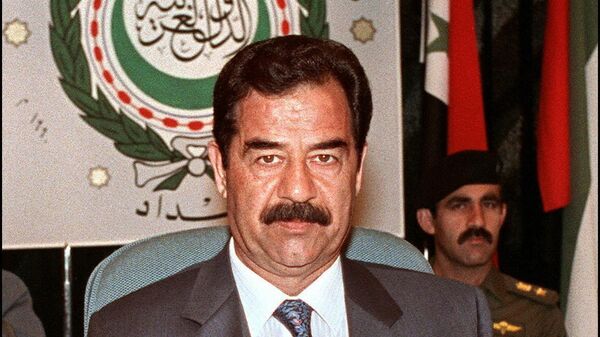MOSCOW (Sputnik) — Saddam Hussein Abd al-Majud al-Tikriti was born on April 28, 1937 in a small village of al-Awja 8 miles from the town of Tikrit to a family of farmers. He was brought up in the house of his maternal uncle Khairallah Talfah, a former Army officer and a firm nationalist who strongly influenced Saddam’s views.
After graduating from secondary school in Baghdad Hussein joined the ranks of the Arab Socialist Ba’ath Party.

In October 1959, Hussein took part in a failed attempt of the Baathists to overthrow Prime Minister Abd Karim Qasim, was wounded and sentenced to death. He managed to escape and fled first to Syria and then to Egypt. In 1962-1963 he studied at the School of Law of Cairo University and actively participated in the party’s life.
In 1963, the Ba’ath party rose to power in Iraq, and Hussein returned to his homeland. He continued studying law in a college in Baghdad, but the same year the government fell, and Hussein was arrested. He spent several years in prison and managed to escape. In 1966, he started taking leading positions in the party, became head of the security service.
Hussein took part in the 1968 coup that brought the Ba’ath party back to power. He became member of the Ba’athist Revolutionary Command Council, the supreme ruling body of the new government. Ahmed Hassan Bakr was named president of Iraq and chairman of the Council. Hussein was Bakr’s deputy, was in charge of the security agencies and gradually managed to gather the real power in his hands.
On July 16, 1979, president Bakr resigned, and Hussein took the office. He also became the leader of the Ba’ath party, the chairman of the Revolutionary Command Council and the commander-in-chief. In years 1979-1991, 1994-2003 Hussein was the prime minister of Iraq.
In September 1980, Hussein commanded to start the invasion of Iran. The devastating war that followed only ended in 1988. An estimated 1.7 million people died during the conflict. In August 1990, Saddam attempted to annex Kuwait. The UN condemned the annexation, and in February 1991 an international coalition ejected Iraqi army from Kuwait.
In March 2003, the United States and the United Kingdom invaded Iraq after accusing the Iraqi government of attempts to create weapons of mass destruction and of organizing and financing of international terrorism.
On April 17, 2003, Hussein’s government fell and he had to go into hiding. On December 13, 2003 he was found in an underground cave not far from Tikrit.
On June 30, 2004, Saddam together with 11 members of his regime was handed over to the Iraqi government. On July 1, the first seating of the court took place. The former president was charged with invading Kuwait (1990), suppressing Kurdish and Shia rebellions (1991), genocide against the Kurds (1987-1988), gas attack at Halabja town (1988), killings of religious leaders (1974), killings of 8 thousand Kurds from the Barzani tribe (1983), killings of political opponents.
On November 5, 2006, Saddam was found guilty in the killing of 148 Shiites, including women, children and elderly, of the Shia village of al-Dujail. The former president was sentenced to death. The rest of the cases were not investigated in view of the already existing death sentence.
On December 3, 2006, Saddam appealed against the sentence, but on December 26, the court confirmed the conviction. On December 30, 2006, Saddam Hussein was executed by hanging.
He was buried in his home village al-Awja near Tikrit.
Saddam Hussein had four wives and five children – two sons and three daughters. Both his sons, Udai and Qusai, were killed in 2003 in Mosul during coalition’s special operation.



